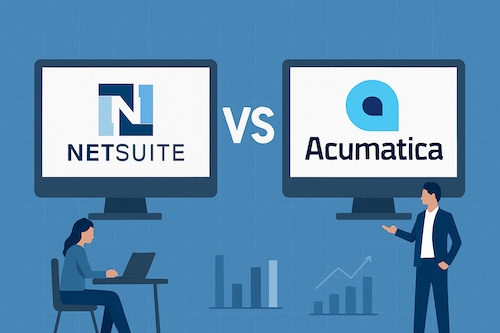
Table of Contents
The Mid-Market ERP Decision: NetSuite vs. Acumatica
Mid-market organizations face a critical decision when selecting an ERP platform that will serve their needs both today and through future growth phases. Two cloud-native solutions (NetSuite and Acumatica) consistently appear at the top of evaluation lists for companies seeking modern, flexible systems.
My research into implementation patterns and customer experiences reveals important distinctions between these platforms that go beyond marketing materials. This comparison examines architectural approaches, pricing models, customization capabilities, and integration ecosystems to provide decision-makers with practical insights.
Technical Architecture and Platform Approach
NetSuite pioneered the cloud ERP space with a true multi-tenant architecture where all customers operate on the same version with a consistent bi-annual release schedule and mandatory upgrades. The platform uses an Oracle database backend with proprietary development stack, delivering strong economies of scale and uniform upgrade experiences, though sometimes limiting customization options.
Acumatica takes a more flexible approach with multi-tenant capability plus options for private instance deployment. Built on Microsoft SQL Server utilizing .NET framework, it offers customer-controlled upgrade scheduling and multiple deployment options including Acumatica-hosted, private cloud, and on-premises solutions. This flexibility allows organizations to match deployment models to their specific regulatory requirements and IT strategies.
Pricing Models and Total Cost of Ownership
A key philosophical difference between the platforms lies in their pricing approaches. NetSuite maintains a traditional SaaS licensing model with per-user monthly fees, tiered functional modules with additional costs, and separate development environment fees. This provides predictable per-user costs but can become expensive as organizations grow their user base, particularly if not managed proactively.
Acumatica disrupted the market with its consumption-based pricing where transaction volume and resource utilization are primary cost drivers, allowing unlimited user access without per-user fees. This approach eliminates the “hidden user” problem where organizations limit system access to control costs, though it can introduce less predictable cost structures for businesses with volatile transaction volumes or those not accustomed to resource-based billing.
Customization Capabilities and Integration Ecosystems
NetSuite’s SuiteCloud platform provides extensive customization options through SuiteScript (JavaScript-based), SuiteFlow (visual workflows), and SuiteTalk (web services integration). The platform boasts 500+ certified SuiteApp integrations in its marketplace, though the proprietary nature of some components can create dependency on NetSuite-specific development resources.
Acumatica emphasizes configuration over coding with C# and .NET-based development for complex extensions. Its open API architecture encourages third-party development with approximately 250+ validated integrations. While smaller than NetSuite’s ecosystem, Acumatica’s marketplace is growing rapidly and features strong support for modern integration approaches.
Practical Selection Guidance
Consider NetSuite when your organization requires mature multi-subsidiary capabilities, values predictable vendor-managed upgrade cycles, or has significant international operations. NetSuite’s strongest vertical solutions typically align with technology, services, and distribution.
Consider Acumatica when your organization places high value on deployment flexibility, expects transaction volume growth to outpace user count growth, or requires stronger project accounting or construction management capabilities. Organizations preferring more control over upgrade timing or aligning with a Microsoft technology stack often favor Acumatica. Furthermore, the specific approach each platform takes to role-based security models can be a deciding factor for organizations with stringent internal control requirements.
Decision Framework
To structure your evaluation process, consider this approach:
- Define future state requirements and prioritize evaluation criteria.
- Conduct scripted demonstrations, ideally using your own data scenarios.
- Perform reference checks with similar organizations to gain real-world perspectives.
- Calculate total cost of ownership (TCO) across a realistic 5-year horizon.
- Assess implementation partner options and their specific expertise for both platforms.
- Develop a decision matrix scoring options against your weighted criteria.
Both NetSuite and Acumatica continue to evolve. NetSuite is increasing integration with Oracle’s broader cloud portfolio, while Acumatica expands its construction and field service capabilities. Both are investing in embedded analytics, machine learning, and enhanced API capabilities for composable ERP strategies.
The choice should reflect your organization’s specific requirements, growth plans, and technical strategy. Both offer capable cloud ERP foundations for mid-market growth.
Feel free to connect with me on LinkedIn if you’d like to discuss specific aspects of your evaluation process.